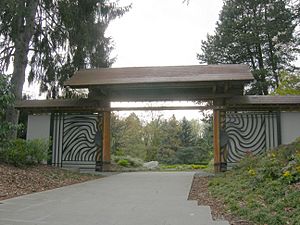Kubota Garden facts for kids
Kubota Garden is a beautiful 20-acre (81,000 m²) Japanese garden located in the Rainier Beach area of Seattle, Washington. This amazing garden has been a public park since 1987. It was first started in 1927 by Fujitaro Kubota, who came to America from Japan. Today, the Seattle Parks and Recreation department and the Kubota Garden Foundation work together to keep it beautiful for everyone to enjoy.
Contents
History of Kubota Garden
Fujitaro Kubota moved from Shikoku, Japan in 1907. He loved gardening and started his own company, Kubota Gardening Company, in 1923. He created many beautiful gardens, including one at Seattle University. He also designed the Japanese garden at Bloedel Reserve on Bainbridge Island.
Creating the Garden
In 1927, Fujitaro bought about 5 acres (20,000 m²) of swampy land in Rainier Beach. This was where he began to build his dream garden. By 1930, the garden grew to 30 acres (120,000 m²). Kubota Garden was more than just a garden; it was a special place for the Japanese community in Seattle. It was also Fujitaro's home, office, and plant nursery.
World War II and Rebuilding
During World War II, the Kubota Garden was left empty for four years. This happened because Fujitaro and his family were forced to move to a special camp called Camp Minidoka in Idaho. Many Japanese Americans were sent to these camps during the war. Even while he was at the camp, Fujitaro helped build a community park there, which included a Japanese rock garden. After the war ended, he and his sons, Tak and Tom Kubota, worked hard to rebuild their business and the garden.
A Special Award and Public Park
In 1972, the Japanese government gave Fujitaro Kubota a special award. It was called the Fifth Class Order of the Sacred Treasure. He received it for his great work in America and for helping people understand and appreciate Japanese gardens. Fujitaro continued to care for the garden until he passed away in 1973.
In 1981, a part of the garden, about 4.5 acres (18,000 m²), was named a historical landmark by the City of Seattle. This meant it was a very important place to protect. In 1987, the City of Seattle bought the garden from the Kubota family. Now, the Department of Parks and Recreation, along with volunteers from the Kubota Garden Foundation, help maintain it.
Expanding the Park
The city also bought another 17 acres (69,000 m²) around the park. This was done to protect Mapes Creek, a stream that flows through the garden. In 1999, work began on a new part of the garden called the Tom Kubota Stroll Garden, which opened in 2000. A new entrance gate, designed by artist Gerard Tsutakawa, was added in 2004.
Kubota Garden Foundation
The Kubota Garden Foundation is a special group that helps the garden. It's a non-profit organization, which means it doesn't try to make money. It was started in 1989. Its main goal is to "support, enhance, and perpetuate the Kubota Garden." This means they want to help the garden grow and last for a long time, just as Fujitaro Kubota wanted.
Fujitaro hoped the garden would be open to everyone. He also wanted it to help Americans learn more about and enjoy Japanese gardens. The foundation helps by raising money, organizing volunteers, and sharing information about the garden.
Features and Programs
The Kubota Garden is open to everyone every day, from sunrise to sunset, all year long. Many different groups visit, including school children, older adults, tourists, and garden clubs.
Garden Highlights
Some of the most interesting parts of Kubota Garden include:
- The Kubota Terrace
- The Bamboo Grove
- The Necklace of Ponds
- The Mountainside
- The Tom Kubota Stroll Garden
Public Tours and Plants
If you want to learn more, the Kubota Garden offers public tours. These tours happen on the fourth Saturday of each month, from April to October.
The garden is home to many different kinds of trees and plants. Some of these include:
- Kuretake (Phyllostachys nigra), also known as Black Bamboo
- Japanese Maple (Acer palmatum)
- Blue Atlas Cedar (Cedrus atlanticus Glauca)
- Norway Spruce (Picea abies)
Images for kids











